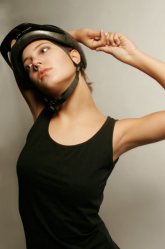
(Photos by Norah Hoover)
Reed College art major Paul Clay has launched BikeSexy.com, which is a series of photos he says use the advertising industry’s oldest methods of persuasion — desirability and sex — to get more people to wear helmets.
“If we plan on promoting bikes within a modern American context, people need to associate bikes with being hot and sexy.”
— Paul Clay, artist
The images were shot by Norah Hoover, a professional photographer and graduate of Reed and the Pacific Northwest College of Art. The models are Reed College students. Clay directed the project and he also does interactive video art and makes music.
Clay shared with me via email yesterday that he’s “very interested in transportation activism” and that he’s worked hard to promote bikes to students and staff at Reed. “I am constantly thinking how I can use my interest in art and technology to get people out of their cars.”
I asked Clay to tell me more about his motivations for the project and I think his response deserves to be re-published in its entirety:



To me, the helmet represents so much of what is indigestible for a greater audience about bikes and bike culture. By its very nature, it implies that a rider is clumsy (that soon you will fall off your bike), faint-hearted, and talentless. It implies that a rider will eventually get hit by a car. It is often associated with bike-racing and the Lycra skivvies, and obviously poses a hazard to a fancy hair-do. So, it’s pretty much the anti-Christ of accepted mainstream fashion. Even in Portland, helmets are not always part of a bike-hipster’s getup.
The advertising industry regularly uses association with sex to propagate new styles of clothing, cars, pharmaceuticals etc. This is particularly obvious in the fashion world: they have the amazing ability to take any object (think crazy huge and expensive purses) or concept (like adopting children) and make it desirable by the use of idealized and erotic imagery.
So the purpose of the photo-shoot was to use the ad industry techniques to associate bike helmets with desirability and sex. This hopefully can have the effect of swaying current bicyclists to wear a helmet more often. However, It’s main drive is to use the bike helmet as symbol of bicycling (and it’s negative associations) and then try to change how that symbol is viewed. From clumsy and prudish to nimble and chic.
Not enough people are swayed by the standard arguments of “better for you, your community and the environment.” If we plan on promoting bikes within a modern American context, people need to associate bikes with being hot and sexy.
The current photo-shoot featured on bikesexy.com is made to appeal to a broad audience. It’s bike propaganda that, instead of playing up bike culture’s “radness” and hip alternative lifestyle, works within a very mainstream formula – hoping to encourage people from a very diverse background to hop on their two-wheeled friends.
I hope we’ll be seeing more activism from Mr. Clay in the future. Check out more photos from this project at BikeSexy.com.

